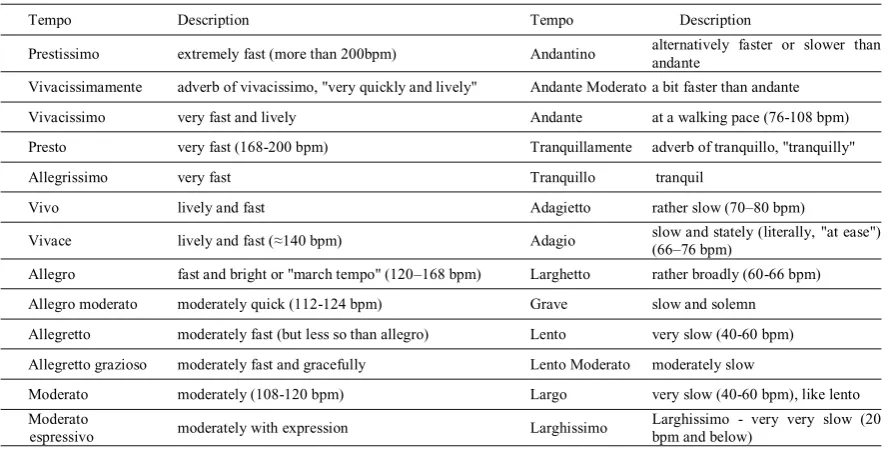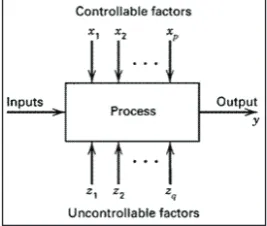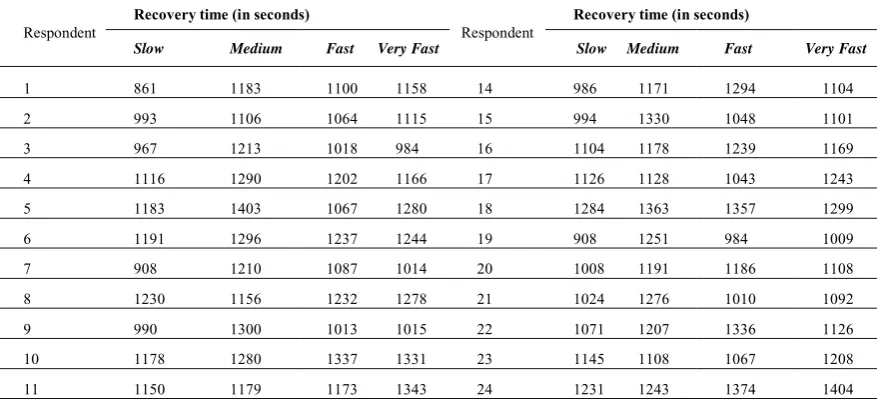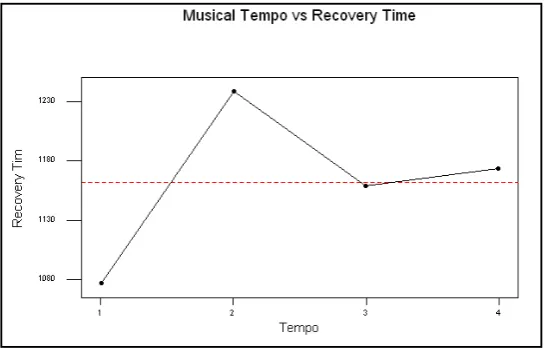2351-9789 © 2015 The Authors. Published by Elsevier B.V. This is an open access article under the CC BY-NC-ND license (http://creativecommons.org/licenses/by-nc-nd/4.0/).
Peer review under responsibility of the organizing committee of the Industrial Engineering and Service Science 2015 (IESS 2015) doi: 10.1016/j.promfg.2015.11.009
Procedia Manufacturing 4 ( 2015 ) 17 – 22
ScienceDirect
Industrial Engineering and Service Science 2015, IESS 2015
The effect of pop musical tempo during post treadmill exercise
recovery time
Herry Christian Palit
a*, Debora Anne Yang Aysia
ba,b Industrial Engineering Department, Petra Christian University, Surabaya, Indonesia,
Abstract
One of the ergonomics focus is work environment, which consist of physical work environment (illumination, climate, noise, etc) and non-physical work environment (working atmosphere). Music is a part of work environment, which can be used to improve emotion and productivity of workers. Listening to exciting music during exercise significantly affects heart rate, RPE and fatigue onset time (RamezanPour, 2012). The aim of this research is to understand the effect of pop musical tempo during post treadmill exercise recovery time. The experiments were done at Ergonomics Laboratory of Petra Christian University. A ten minutes treadmill exercise with a certain speed scenario and without musical background was chosen as a physical activity. The recovery time is recorded during the recovering process while respondent listening pop musical tempo with adjusted tempo. There are four level of pop musical tempo which were chosen, they are slow (66-76 bpm), medium (76-120 bpm), fast (120-168 bpm), and very fast (168-200 bpm). The desired response is faster heart rate recovery time. Randomize Complete Block Design was used as an experimental method. This study concluded that pop musical tempo significantly affects the post treadmill exercise recovery time, and slow tempo (66-76 bpm) has the fastest recovery time than the others.
© 2015 The Authors. Published by Elsevier B.V.
Peer-review under responsibility of the organizing committee of the Industrial Engineering and Service Science 2015 (IESS 2015).
Keywords:Pop; musical tempo; recovery time; treadmill exercise
1. Introduction
Ergonomic is the study of human characteristics for the appropriate design of the living and working environment [1]. Ergonomics focuses on human beings and their interaction with products, equipment, facilities, procedures, and
* Corresponding author. Tel.: +0-000-000-0000 ; fax: +0-000-000-0000 .
E-mail address: [email protected]
© 2015 The Authors. Published by Elsevier B.V. This is an open access article under the CC BY-NC-ND license (http://creativecommons.org/licenses/by-nc-nd/4.0/).
environments used in work and everyday living [2]. The objective of Ergonomics is to enhance the effectiveness and efficiency with which work and other activities are carried out and to enhance certain desirable human values.
Work environment is one of Ergonomic focus, which consist of physical work environment (illumination, climate, noise, etc.) and non-physical work environment (working atmosphere). Music as a part of physical work environment is a collection of tones that are arranged to produce rhythm, song and harmony. Music can be used to improve emotion and productivity of workers. RamezanPour [3] investigated the effects of listening to music during exercise on heart rate, blood pressure, rating of perceived exertion (RPE) and fatigue onset time. They reported that listening to exciting music during exercise significantly affects heart rate, RPE and fatigue onset time. Musical tempo can be defined as the pace or speed at which a section of music is played. Damschroder [4] state that a music which has tempo 120 bit per minutes can be categorized as fast tempo, meanwhile a music which has tempo 40 bit per minutes can be categorized as slow tempo. Mudjilah [5] divided musical tempo into three classes, which are fast tempo (allegro, allegretto allegresimo, presto), moderate tempo (moderato, allegro moderato, andante), and slow tempo (largo, largissimo, largeto, grave). Musical tempo classification can be seen in Table 1.
Table 1. Musical tempo classification
Tempo Description Tempo Description
Prestissimo extremely fast (more than 200bpm) Andantino alternatively faster or slower than andante
Vivacissimamente adverb of vivacissimo, "very quickly and lively" Andante Moderato a bit faster than andante
Vivacissimo very fast and lively Andante at a walking pace (76-108 bpm)
Presto very fast (168-200 bpm) Tranquillamente adverb of tranquillo, "tranquilly"
Allegrissimo very fast Tranquillo tranquil
Vivo lively and fast Adagietto rather slow (70–80 bpm)
Vivace lively and fast (≈140 bpm) Adagio slow and stately (literally, "at ease") (66–76 bpm)
Allegro fast and bright or "march tempo" (120–168 bpm) Larghetto rather broadly (60-66 bpm)
Allegro moderato moderately quick (112-124 bpm) Grave slow and solemn
Allegretto moderately fast (but less so than allegro) Lento very slow (40-60 bpm)
Allegretto grazioso moderately fast and gracefully Lento Moderato moderately slow
Moderato moderately (108-120 bpm) Largo very slow (40-60 bpm), like lento
Moderato
espressivo moderately with expression Larghissimo
Larghissimo - very very slow (20 bpm and below)
Several researches about the effect of musical tempo on the fatigue recovery time also have been done. Savitha [6] state that music with fast tempo (more than 120 beats/min) has a relaxant effect which allows the person to exert to the same extent with less calories burnt and exercise at a lower heart rate and lesser oxygen consumption. Meanwhile,
Manjunantha [6] and Bhavsar [7] state that slow music has greater relaxation effect than fast or no music. These two researchers have found a different result. That is why; this research is conducted to gain a better understanding about the effect of musical tempo during post treadmill exercise recovery time. This research uses the same musical genre on different musical tempo experiment in order to avoid the effect of musical genre. Pop music was chosen in this research because this kind of music is commonly known and preferable by many people. As mentioned by Banoe [8], pop music is a relaxing light music and entertaining music that favoured by many people. The aim of this research is to understand the effect of pop musical tempo during post treadmill exercise recovery time, and determine which pop musical tempo has best effect to post treadmill exercise recovery time. The recovery time is obtained through monitoring the time needed for a respondent to get a normal heart rate just like before doing a treadmill exercise.
2. Research method
are made to the input variables of a process or system so that we may observe and identify the reasons for changes that may be observed in the output response [9]. The objective of an experiment is to determine the influence of some factors (input factor or process factor) toward the output response of the system. General model of a system can be seen in Fig. 1.
Fig. 1. General model of a system.
The aim of this experiment is to know the effect of pop musical tempo towards post treadmill exercise recovery time, and determine which pop musical tempo which has best effect to the recovery time. Response for this experiment is respondent's recovery time after treadmill exercise. The recovery time is obtained from the time needed for a respondent to get a normal heart rate, after doing a ten minutes treadmill exercise. The characteristic of the response is lower the better, which means the fastest recovery time is desired. Factor for this experiment is pop musical tempo which has four levels. They are slow tempo (66-76 bpm), medium tempo (76-120 bpm), fast tempo (120-168 bpm), and very fast tempo (168-200 bpm). Songs that have been chosen for each level are “Kesalahan yang sama” by Kerispatih for slow tempo (73 bpm), Let it go by Demi Lovato for medium tempo (97 bpm), Like a G6 by Far Ease Movement for fast tempo (125 bpm), and Lovely by Kim Jong Kook for very fast tempo (188 bpm). The songs were chosen based on the respondent favourite pop song.
There are three basic principles to conduct an experiment; they are randomization, replication, and blocking. By randomization the order experiment's runs are randomly determined. By replication an independent repeat of each factor combination are satisfied. Blocking is used to reduce or eliminate the variability of nuisance factor, factor that may influence the experimental response, but not the main purpose of the experiment. Randomized Complete Block Design (RCBD) is one of the design techniques that is used to against nuisance factors. This method usually use when there is one factor and one nuisance factor. Randomized Complete Block Design is chosen as the experimental method in this study. Respondent is chosen as a nuisance factor and being blocked in order to minimize the effect of the respondent's variation. The physical activity is a ten minutes treadmill exercise with certain speed scenario and without musical background. Speed of 4 km/hour is used for the first two minutes, speed of 6 km/hour is used for the next four minutes, and speed of 7 km/hour is used for the last four minutes
Table 2. Experiment run order
Hand phone is used as a music player and respondents listen to the pop music using a headset so they can adjust the music volume at their desired level. All of the respondents use the same hand phone and headset in order to omit the effect of the player variation. Heart rate monitor device and stopwatch are used to record the respondent recovery time.
The experiment's response is respondents' recovery time after 10 minutes treadmill exercise. Factor that is suspected affect the respondents' recovery time is musical pop tempo, with four levels of tempo. The experimental data will be analysed by using ANOVA test to determine whether pop musical tempo is significantly affect the respondents' recovery time or not. Main effect analysis will be used to determine which level of the pop musical tempo has best effect towards respondents' post treadmill exercise recovery time.
3. Result and discussion
The experiment was conducted at Ergonomic Laboratory, Petra Christian University. Some conditions inside the laboratory have been controlled in order to minimize the effect of extraneous factors such as room temperature, lighting, and noise. Respondent will get one treatment per day. For each treatment, initial heart rate was taken for five minutes, before respondent do the exercise. After ten minutes treadmill exercise, respondent will relax while listening to the music with certain tempo, according to randomization sequence that has been done before. The time will be counted from the beginning of relaxing time until their heart rate back to the normal heart rate range, just like before they do a treadmill exercise. The experimental data can be seen in Table 3.
12 1181 1320 1370 1354 25 1199 1300 1133 1223
13 888 1290 1004 972
The experimental data will be analyzed to determine whether pop musical tempo is significantly affects respondents' recovery time or not. The Minitab output for ANOVA test can be seen at Figure 2. The residuals are Normally Independent Distributed, so the ANOVA test assumption is satisfied.
Fig. 2. ANOVA test.
The null hypothesis for this experiment is pop musical tempo doesn't significantly affect post treadmill exercise recovery time, while the alternative hypothesis is pop musical tempo significantly affect post treadmill exercise recovery time. It can be seen in Fig. 2 that P value for the musical tempo is 0.000. Its means that pop musical tempo significantly affects post treadmill exercise recovery time at 0.05 significant levels. Main effect analysis is done to determine which level of pop musical tempo has best effect to the recovery time. A lower time is desired and it will indicate the fastest post treadmill exercise recovery time. The main effect plot for the recovery time can be seen in Fig. 3. The faster recovery time is obtained when respondent have a relaxing time with hearing a slow tempo pop music (66-76 bpm), which means pop music with slow tempo gives the fastest heart rate recovery time after doing a treadmill exercise; compared to medium tempo, fast tempo and very fast tempo. There could be respondent preference on certain song will take effect, but this effect has been investigated in the other research.
4. Conclusion
The experiment result concludes that pop musical tempo significantly affects the post ten minutes treadmill exercise recovery time. The fastest heart rate recovery time after treadmill exercise is pop music with slow tempo (66-76 bpm). Further research can be done for analysing the effect of musical tempo towards post treadmill exercise recovery time, for the other musical genre, such as classic, jazz, etc. Further research also can be done for analysing the effect of musical tempo towards the other kind of exercise and physical activity.
Acknowledgements
The authors thank to Kevin Hadisurya, Novia Veronika Yuliani, Sonny Sugiarto, and Jonathan Wijaya Gunawan who have been helped in the preparation and implementation of this experiment.
References
[1] K.H.E. Kroemer, H.B. Kroemer, K.E. Kroemer-Elbert, Ergonomics: How to Design for Ease and Efficiency, 2nd ed., Prentice
Hall, 2001.
[2] M.S. Sanders, E.J. McCormick, Human Factors in Engineering and Design. Mc Graw-Hill, 1993.
[3] M.R. RamezanPour, A. Moghaddam, E. Sadifar, Comparison the Effects of Listening to Three Types of Music during Exercise on Heart Rate, Blood Pressure, Rating of Perceived Exertion and Fatigue Onset Time.Iranian Journal of Health and Physical Activity, 3(1), 2012, pp. 15-20.
[4] D.A. Damschroder, Foundation of Music and Musicianship, 3rd ed.,Cengage Learning, 2005.
[5] H.S. Mudjilah, Diktat Teori Musik Dasar, Yogyakarta: Universitas Negeri Yogyakarta, 2001.
[6] D. Savitha, D. T.V. Sejil, R. Shwetha, C.J. Roshan, The Effect of Vocal and Instrumental Music on Cardio Respiratory Variables, Energy Expenditure and Exertion Levels during Sub Maximal Treadmill Exercise. Indian J. Physiol Pharmacol,
57(2), 2013, pp. 159-168.
[7] S.N. Manjunatha, D.M.L Revathi, A.T. Sharan, S.G. Chandrakumar, I. Sapna , Cardiovascular responses to different musical tempo during post exercise recovery in healthy medical students.International Journal of Biological & Medical Research, 5(2), 2014, pp. 4031-4035.
[8] S.D. Bhavsar, R.S. Abhange, S. Afroz, Effect of Different Musical Tempo on Post-Exercise Recovery in Young Adults. IOSR Journal of Dental and Medical Sciences, 13(1), 2014, pp. 60-64.



